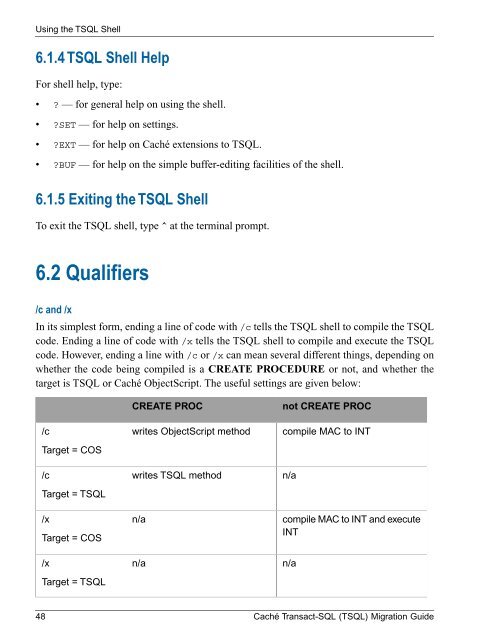Caché Transact-SQL (TSQL) Migration Guide - InterSystems ...
Caché Transact-SQL (TSQL) Migration Guide - InterSystems ...
Caché Transact-SQL (TSQL) Migration Guide - InterSystems ...
Create successful ePaper yourself
Turn your PDF publications into a flip-book with our unique Google optimized e-Paper software.
Using the T<strong>SQL</strong> Shell6.1.4 T<strong>SQL</strong> Shell HelpFor shell help, type:• ? — for general help on using the shell.• ?SET — for help on settings.• ?EXT — for help on <strong>Caché</strong> extensions to T<strong>SQL</strong>.• ?BUF — for help on the simple buffer-editing facilities of the shell.6.1.5 Exiting the T<strong>SQL</strong> ShellTo exit the T<strong>SQL</strong> shell, type ^ at the terminal prompt.6.2 Qualifiers/c and /xIn its simplest form, ending a line of code with /c tells the T<strong>SQL</strong> shell to compile the T<strong>SQL</strong>code. Ending a line of code with /x tells the T<strong>SQL</strong> shell to compile and execute the T<strong>SQL</strong>code. However, ending a line with /c or /x can mean several different things, depending onwhether the code being compiled is a CREATE PROCEDURE or not, and whether thetarget is T<strong>SQL</strong> or <strong>Caché</strong> ObjectScript. The useful settings are given below:/cTarget = COS/cTarget = T<strong>SQL</strong>/xTarget = COS/xTarget = T<strong>SQL</strong>CREATE PROCwrites ObjectScript methodwrites T<strong>SQL</strong> methodn/an/anot CREATE PROCcompile MAC to INTn/acompile MAC to INT and executeINTn/a48 <strong>Caché</strong> <strong>Transact</strong>-<strong>SQL</strong> (T<strong>SQL</strong>) <strong>Migration</strong> <strong>Guide</strong>

















